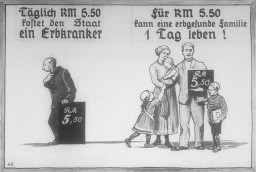
How did the shared foundational element of eugenics contribute to the growth of racism in Europe and the United States?
The meanings of “race” and “racism” have varied over time and in different political, social, and cultural settings. Some of the developments underpinning early 20th century racism were common to countries across the western world. This discussion question focuses on the history of racial antisemitism in Germany and its relationship to racism in the United States. Learn more about the shared foundational element of eugenics.
See related articles for background information related to this discussion.
Background
In both Nazi Germany and the United States in the same period, racism had deep historical roots. Hostility toward Jews and people of color had long been justified on various grounds. Among the reasons were religious prejudice and economic ideas linked to slavery and colonialism. What was new in the early 20th century was the use of science or scientific-sounding ideas to rationalize racism and new, racial forms of antisemitism. For example, the eugenics movement was influential at this time. False “scientific” ideas regarding race included beliefs that:
- human populations can be divided into distinct biological groups called “races”;
- these “races” can be ranked in a hierarchy.
This era was one of “scientific racism.” Some of the most prominent scientists and intellectuals legitimized these ideas. Scientists today have overwhelmingly rejected such beliefs.
“Scientific racism” both reflected and justified imperialism at its height. Imperialism was the drive by many western countries to expand their economies and power by laying claim to colonies and territories worldwide. To legitimize these efforts, leaders and many citizens of the imperialist powers promoted theories of superiority and “white supremacy” over peoples of color—such as Asians and Africans—living under colonial rule. Germany and the United States were among the imperialistic countries.
Advocates of white supremacy drew on ideas known as “social Darwinism.” To serve their beliefs, they adapted concepts that Charles Darwin and other scientists applied to plants and animals. “Survival of the fittest” was used to justify a number of racist beliefs. It was applied to imperialism, totally unregulated (“laissez-faire”) capitalism, racism, and the pseudo-science of eugenics.
Eugenics first emerged in Great Britain in the late 19th century. Its supporters advocated a higher birth rate for white people of “good” stock. They also sought to limit the reproduction of individuals viewed as hereditarily “defective” or “inferior.” In Europe and the United States, eugenicists called for the forced sterilization of “the unfit.” They considered a person “unfit” if they had mental illnesses or disabilities deemed inherited.
The United States
Eugenicists influenced several areas of American society. Some states passed sterilization laws. Eugenicists also supported immigration restrictions. Country quotas, for example, served to reduce the numbers of Catholic and Jewish immigrants, keep out Asians, and prevent Mexican migrant laborers from becoming US citizens. The goal of the quotas was to ensure that the United States remained a largely white, Anglo-Saxon Protestant society. Racial segregationists also used eugenics to justify discrimination against African Americans and other persons of color. For instance, they used eugenic claims to justify bans on “racially mixed” marriages. They argued that these marriages produced biologically inferior offspring.
Germany
In the 1920s, Germany was led by a democratic government. National proposals for sterilization on eugenic grounds gained only limited political support. Catholics objected to interfering with human reproduction and liberals decried the violation of individual rights. Nonetheless, extreme nationalists promoted the superiority of the “Nordic” race. They cautioned against the biological dangers of “mixing” European races with non-European “races” and “subraces.” Among those some scientists classified as a “subrace” were Jews.
Formed in 1920, the Nazi Party’s ideology was based on these racist, imperialist, and eugenic ideas. “Science” was used to justify Nazi beliefs—beliefs steeped in social Darwinism at its most extreme.
Racism and Antisemitism Endure
Racism and antisemitism persist in the United States, Europe, and elsewhere, despite the fact that modern science has totally rejected 20th century notions of biologically determined distinct “races.”
After World War II and the Holocaust, eugenics was discredited for several reasons. It was in part due to the genocide and other crimes committed in the name of Nazi racial ideology. Another reason eugenics was discredited was because of more advanced scientific understandings of human genetics. Research has shown that distinct genetic pools as markers of “race” do not exist. Across all humans, DNA is approximately 99.9% the same. In addition, research has shown that all human populations can trace their genetic roots to common origins in East Africa.
Today, the consensus among scientists is that “race” is not a genetic or biological concept. Rather, “race” is a cultural and social concept that has varied depending on time, place, and circumstances—a human invention.
Over the course of history, group targeted hatreds have endured, even if the rationale has sometimes changed. Regardless of the rationale, the targeting of individuals on the basis of skin color, religion, ethnicity, or nationality continues to result in discrimination, persecution, and violence, including mass atrocities and genocide.
Critical Thinking Questions
Research racial laws and practices in Germany and the United States during the 1920s and 1930s. What role did eugenics play in these policies?
Despite overwhelming scientific data to the contrary, many people still believe in the superiority of certain races. Why might individuals hold onto a belief that has been discredited?
How can propaganda and the spread of harmful misinformation about a particular group be identified and countered?






